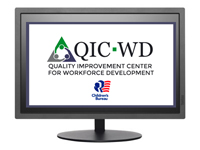Child Welfare Quality Improvement Center for Workforce Development (QIC-WD)
Document Type
Article
Citation
© The Quality Improvement Center for Workforce Development (QIC-WD)
Abstract
QIC-WD Teaming Structure
Overview
As you begin to plan for the first QIC-WD on-site meeting, the QIC-WD WIE team would like you to think about the site’s teaming structure. The development of the site’s governance/teaming structure will occur over time, evolving to meet the changing needs of the initiative. The QIC-WD WIE team will work with the sites to ensure the development of teaming structures that support the work of the initiative.
Characteristics of Effective Teams
Effective teams share the following common characteristics:
- Have passion for and commitment to the initiative
- Have clarity of each team members’ roles and responsibilities
- Have adequate time to do the work required, which might mean being relieved of other responsibilities
- Focus on achievement of collective results and outcomes
- Follow a decision-making process that facilitates decisions, commitment to carrying out decisions and plans of action to enable forward movement of the project • Establish clear goals and objectives
- Periodically review the team’s understanding of the project’s goals and objectives
- Hold one another accountable for achieving their assigned goals or objectives
- Have an organized, efficient and transparent way of communicating with each other
- Build relationships that are established on trust, cooperation, support, and constructive conflict
Essential Team Functions
Teams created to implement and manage an initiative will serve a variety of functions, such as:
- Guide the overall initiative by defining, operationalizing, and implementing the intervention
- Ensure implementation supports are put into place, including structures such as data systems, policies, and staffing, training, technical assistance and coaching and CQI processes
- Ensure the intervention is implemented as intended (i.e., program fidelity)
- Ensure team leadership capacity is developed for the long-term and sustainability is planned for
- Engage with key stakeholders to gain and maintain their buy-in and support for the initiative
- Identify key measures and review program outputs so that adjustments can be made to implementation supports (e.g., fidelity measures, data systems, policy, staffing)
- Support evaluation activities
Read the full document by downloading the file above.
Included in
Industrial and Organizational Psychology Commons, Public Administration Commons, Social Welfare Commons, Social Work Commons, Work, Economy and Organizations Commons


